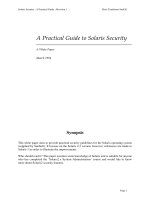Splunk essentials a fast paced and practical guide to demystifying big data and transforming it into operational intelligence 2nd edition
Bạn đang xem bản rút gọn của tài liệu. Xem và tải ngay bản đầy đủ của tài liệu tại đây (11.62 MB, 227 trang )
Splunk Essentials
Second Edition
A fast-paced and practical guide to demystifying big
data and transforming it into operational intelligence
Betsy Page Sigman
Erickson Delgado
BIRMINGHAM - MUMBAI
Splunk Essentials
Second Edition
Copyright © 2016 Packt Publishing
All rights reserved. No part of this book may be reproduced, stored in a retrieval system, or
transmitted in any form or by any means, without the prior written permission of the
publisher, except in the case of brief quotations embedded in critical articles or reviews.
Every effort has been made in the preparation of this book to ensure the accuracy of the
information presented. However, the information contained in this book is sold without
warranty, either express or implied. Neither the authors, nor Packt Publishing, and its
dealers and distributors will be held liable for any damages caused or alleged to be caused
directly or indirectly by this book.
Packt Publishing has endeavored to provide trademark information about all of the
companies and products mentioned in this book by the appropriate use of capitals.
However, Packt Publishing cannot guarantee the accuracy of this information.
First published: February 2015
Second Edition: September 2016
Production reference: 1260916
Published by Packt Publishing Ltd.
Livery Place
35 Livery Street
Birmingham B3 2PB, UK.
ISBN 978-1-78588-946-2
www.packtpub.com
Credits
Authors
Copy Editor
Betsy Page Sigman
Erickson Delgado
Safis Editing
Reviewer
Project Coordinator
Somesh Soni
Suzanne Coutinho
Commissioning Editor
Proofreader
Veena Pagare
Safis Editing
Acquisition Editor
Indexer
Vinay Argekar
Rekha Nair
Content Development Editor
Production Coordinator
Nikhil Borkar
Aparna Bhagat
Technical Editor
Madhunikita Sunil Chindarkar
About the Authors
Betsy Page Sigman is a distinguished professor at the McDonough School of Business at
Georgetown University in Washington, D.C. She has taught courses in statistics, project
management, databases, and electronic commerce for the last 17 years and has been
recognized with awards for teaching and service. Before arriving at Georgetown, she
worked at George Mason University, the U.S. Bureau of the Census,
Decision/Making/Information, the American Enterprise Institute, and the Social Science
Data Center (now Roper Center) at the University of Connecticut.
Her recent publications include a Harvard Business case study and a Harvard Business
review article, articles in the Decision Sciences Journal of Innovative Education and
Decision Line, and a case study in Educause Review Online. Additionally, she is a frequent
media commentator on technological issues and big data.
A big thank you to Nikhil Borkar and Vinay Argekar and the other editors and staff at Packt
Publishing for your help in every step along the way to finishing this book. Thanks also to my
colleagues and students at the McDonough School of Business at Georgetown University. Thanks
especially to Bill Garr, Rob Pongsajapan, Marie Selvanandin, and Kristin Bolling, and the Center for
New Designs in Learning and Scholarship (CNDLS), for exploring the exciting world of big data
and Splunk together. It has been a wonderful place to learn, grow, and serve for the last 16 years.
I need to thank my brothers, Tim and Rick Page, for being there to challenge and encourage me
throughout my life. Most of all, I want to thank my brilliant and wonderful husband, Chuck, my
astonishing daughter and son-in-law, Page and Daniel Thies, and my three sons. Johnny, thanks for
always inspiring me technologically; Richard, thanks for your sense of humor that keeps us all
laughing; and James, thanks for always being there for all of us. Edward and Peter, the grandsons
who light up all our lives, are too young to read this now. They were born into an extraordinary
world—one that I hope and pray technology will continue to improve.
Erickson Delgado is an enterprise architect who loves to mine and analyze data. He began
using Splunk in version 4.0 and has pioneered the use of the application in his current
work. In the earlier parts of his career, he worked with start-up companies in the
Philippines to help build their open source infrastructure. He then worked in the cruise
industry as a shipboard IT manager, and he loved it. From there, he was recruited to work
at the company’s headquarters as a software engineer.
He has developed applications with Python and Node.js. He is interested in Go and is
rediscovering programming with C/C++. He is crazy about visualization platforms and
tools. In recent years, he has engaged himself with employing DevOps in his work.
Since Erickson’s routine revolves around technical practices, he blows off steam by
saltwater fishing, mountain biking, crafting robots, and touring the country. He lives in
Orlando.
To my wife, Emma, thank you for the never-ending support and patience.
About the Reviewer
Somesh Soni is a Splunk consultant with over 11 years of IT experience. He has a bachelor's
degree (Hons.) in computer science and has been interested in exploring and learning new
technologies throughout his life. He has extensive experience in consulting, architecture,
administration, and development in Splunk. He’s proficient in various programming
languages and tools, including C#.NET/VB.NET, SSIS, and SQL Server.
Somesh is currently working as a Splunk Master with Randstad Technologies. His activities
are focused on consulting, implementation, admin, architecture, and support-related
activities for Splunk. He started his career with the one of the top three Indian IT giants. He
has executed projects for major Fortune 500 companies such as Coca Cola, Wells Fargo,
Microsoft, and Capital Group. He has performed in various capacities, including Technical
Architect, Technical Lead, Onsite Coordinator, and Technology Analyst.
Somesh has been a great contributor to the Splunk community and has consistently been at
the top of the list. He is a member of Splunk Trust 2015-16 and overall one of the topmost
contributors to the Splunk Answers community.
I would like to thank my family and colleagues, who have always encouraged and supported me to
follow my dreams, and my friends, who put up with all my crazy antics while I went on a Splunk
exploratory journey and listened with patience to all the tips and tricks of Splunk that I shared with
them.
Last but not least, I would like to express my gratitude to the entire team at Packt Publishing for
giving me this opportunity.
www.PacktPub.com
For support files and downloads related to your book, please visit www.PacktPub.com.
Did you know that Packt offers eBook versions of every book published, with PDF and
ePub files available? You can upgrade to the eBook version at www.PacktPub.com and as a
print book customer, you are entitled to a discount on the eBook copy. Get in touch with us
at for more details.
At www.PacktPub.com, you can also read a collection of free technical articles, sign up for a
range of free newsletters and receive exclusive discounts and offers on Packt books and
eBooks.
/>
Get the most in-demand software skills with Mapt. Mapt gives you full access to all Packt
books and video courses, as well as industry-leading tools to help you plan your personal
development and advance your career.
Why subscribe?
Fully searchable across every book published by Packt
Copy and paste, print, and bookmark content
On demand and accessible via a web browser
Table of Contents
Preface
Chapter 1: Splunk in Action
Your Splunk.com account
Obtaining a Splunk.com account
Installing Splunk on Windows
Logging in the first time
Run a simple search
Creating a Splunk app
Populating data with Eventgen
Installing an add-on
Controlling Splunk
Configuring Eventgen
Viewing the Destinations app
Creating your first dashboard
Summary
Chapter 2: Bringing in Data
Splunk and big data
Streaming data
Latency of data
Sparseness of data
Splunk data sources
Machine data
Web logs
Data files
Social media data
Other data types
Creating indexes
Buckets
Data inputs
Splunk events and fields
Extracting new fields
Summary
Chapter 3: Search Processing Language
1
6
6
7
8
10
12
13
17
18
20
22
23
25
28
29
29
29
30
30
31
31
31
31
31
32
32
34
35
39
40
44
45









